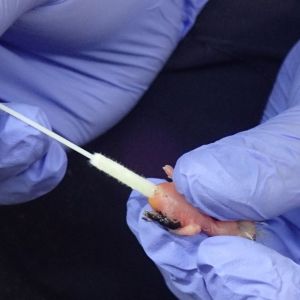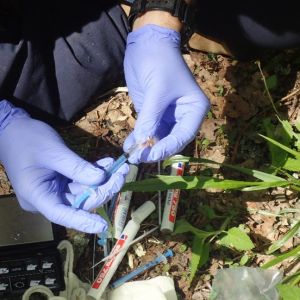The gut microbiome of great tits and blue tits shows high resilience to early- life disturbances

The significance of this finding lies in the long-term effects that the gut microbiome has on its hosts. From reducing the likelihood of immune disease to parasite infections, the presence of an adequate gut microbial community early in life has a positive impact on host health.
But how can tiny great and blue tit hatchlings harbor complex bacterial communities in the first place? Senior author Katerina Sam, Czech Academy of Sciences and University of South Bohemia, said: "Previous studies have shown that birds hatch with nearly sterile guts, and in the case of tits, once they are in the nest, they are quickly colonized by bacteria until a well-established microbial community is present after 8-10 days. We wanted to explore how this colonization works, and the best way we could think of was by altering it."
The team, consisting of researchers from the Czech Academy of Sciences and the University of Copenhagen, then began planning an experiment that would take place during the breeding season - usually between April and June in Central Europe - when Tit clutches hatch and the colonization process begins. There are two ways to alter a bacterial community: with antibiotics or with probiotics, and they decided to try both. In each experimental nest, the researchers administered antibiotics to two chicks and probiotics to two others for nearly two weeks, while the last two experimental chicks in each nest served as controls.
Disruptions in the process of colonizing the gut could affect nutrient absorption and thus limit growth. Each time the researchers applied a treatment, they weighed the chicks and took a microbiome sample by gently swabbing the chick's cloaca.
They found that the gut colonization was resilient enough to overcome such perturbations, and that the source of this bacterial input was primarily the bacterial community in the nest, followed by vertical transmission from females. The results have been recently published in the journal Molecular Ecology.
The researchers expected a general effect of antibiotics and probiotics on chicks from different nests, since antibiotics generally inhibit the growth of certain bacteria, while probiotics are expected to promote beneficial bacteria. However, this was not the case: "We were surprised in some ways that the treatments had no measurable effect on the growth and bacterial community of the chicks, since poultry have been treated with antibiotics for decades to improve growth and avoid certain pathogenic bacteria. So, we kept digging to find out how the gut microbiome might be resilient to such disruptions" said co-lead author Kasun H. Bodawatta, University of Copenhagen".
The microbial nest environment was found to be the main contributor to the chick gut microbiome, and researchers hypothesized a continuous colonization from the nest that impeded the treatments to be effective. In fact, the gut microbiome of siblings resembles each other to a greater degree than that of unrelated neighbors. "The similarity of gut and nest microbiome is important in that the microbial communities in the nest depend on the nest material selected by females, that is an indirect maternal influence on the gut microbiome of chicks," said co-lead author David Diez-Méndez, Czech Academy of Sciences.
However, there are some aspects that differ between great tits and blue tits. The research team found that neighboring great tits had more different gut microbiomes the farther away their nests were, whereas neighboring blue tits did not exhibit this distance relationship. Differences in habitat or prey quality may explain this pattern, since Great tits are usually dominant over Blue tit because of their size difference.
The current study tries to give explanations to differences between species, as well as the reasons for the more similar gut microbiomes between chicks and mothers as opposed to fathers, which appear to harbor a different microbial community. Sam stresses that more research is needed to truly understand the process of gut colonization in these hole-nesting species. "We know that the chick gut microbiome comes from the nest, from the mother, and to a lesser extent from the father, but those three sources explain at most half of it; we need to figure out the whole colonization process and the exact contribution of each source”.
Reference: Diez‐Méndez, D., Bodawatta, K. H., Freiberga, I., Klečková, I., Jønsson, K. A., Poulsen, M., & Sam, K. (2023). Indirect maternal effects via nest microbiome composition drive gut colonization in altricial chicks. Molecular Ecology. https://doi.org/10.1111/mec.16959




